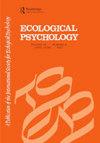Predictability and Variability of a Dynamic Environment Impact Affordance Judgments
IF 1.8
3区 心理学
Q3 PSYCHOLOGY, EXPERIMENTAL
引用次数: 10
Abstract
Abstract A crucial component of locomotion and mobility is the successful navigation of apertures (e.g., doorways, lanes, corridors). While much research has studied perceptions of action capabilities in a static environment, far less work has considered how action capabilities change in a dynamic environment, particularly when the environment moves in unpredictable ways. The current experiment assessed actors’ perceptions of aperture passability for a dynamically moving gap. In an immersive virtual environment, participants were seated in a wheelchair rolling toward a sliding door while the door oscillated to various widths. The patterns of oscillation were manipulated in terms of their amplitude (sequence standard deviation), predictability (sequence sample entropy), and base width (sequence mean) in a within-participants design. Participants gave judgments of passability within a temporal occlusion paradigm. Results showed that both the amplitude and predictability of the oscillating door impacted the reliability of passability judgments. We suggest that these variables act to alter the salience of optical constraints (e.g., attractors and repellors) within a dynamical systems framework.动态环境影响可视性判断的可预测性和可变性
摘要运动和机动性的一个关键组成部分是成功导航孔隙(例如,门口、车道、走廊)。虽然许多研究研究了静态环境中对行动能力的感知,但很少有研究考虑行动能力在动态环境中如何变化,尤其是当环境以不可预测的方式移动时。目前的实验评估了演员对动态移动间隙的光圈可通过性的感知。在一个身临其境的虚拟环境中,参与者坐在轮椅上,朝着滑动门滚动,同时门摆动到不同的宽度。在参与者内部设计中,根据振幅(序列标准差)、可预测性(序列样本熵)和基底宽度(序列平均值)来操纵振荡模式。参与者在时间闭塞范式中给出了通过性的判断。结果表明,摆动门的振幅和可预测性都影响了通过性判断的可靠性。我们认为,在动力学系统框架内,这些变量的作用是改变光学约束(如吸引子和排斥子)的显著性。
本文章由计算机程序翻译,如有差异,请以英文原文为准。
求助全文
约1分钟内获得全文
求助全文
来源期刊

Ecological Psychology
PSYCHOLOGY, EXPERIMENTAL-
CiteScore
3.30
自引率
10.50%
发文量
8
期刊介绍:
This unique journal publishes original articles that contribute to the understanding of psychological and behavioral processes as they occur within the ecological constraints of animal-environment systems. It focuses on problems of perception, action, cognition, communication, learning, development, and evolution in all species, to the extent that those problems derive from a consideration of whole animal-environment systems, rather than animals or their environments in isolation from each other. Significant contributions may come from such diverse fields as human experimental psychology, developmental/social psychology, animal behavior, human factors, fine arts, communication, computer science, philosophy, physical education and therapy, speech and hearing, and vision research.
 求助内容:
求助内容: 应助结果提醒方式:
应助结果提醒方式:


